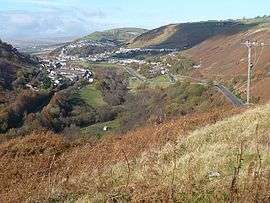Rhymney Valley
The Rhymney Valley (Welsh: Cwm Rhymni) is one of the South Wales valleys. After the abolition of the counties of Glamorgan and Monmouthshire in 1974, Rhymney Valley was created as one of the districts of Mid Glamorgan.[1] The valley encompasses the villages of Abertysswg, Fochriw, Pontlottyn, Tir-Phil, New Tredegar, Aberbargoed, Rhymney, and Ystrad Mynach, and the towns of Bargoed and Caerphilly.
Geography

Created as a glacial valley, now the Rhymney River flows largely south to Rumney, a district of Cardiff. The river is the ancient boundary between Glamorgan and Monmouthshire.
Groesfaen, Deri, Pentwyn and Fochriw are located in the Darran Valley and not the Rhymney Valley. This valley joins the Rhymney Valley at Bargoed
Llanbradach is a large village in the Rhymney Valley between Ystrad Mynach and Caerphilly,
History
This valley is one of the South Wales Valleys, and its history largely follows theirs: sparsely populated until the nineteenth century; industrialised for iron, steel and coal; industrial decline in the 1980s and 1990s. The Rhymney Valley produced a miner poet, Idris Davies of Rhymney, famous for his poems associated with the locality and the struggles of its people.
The 1990s brought improved road connections to the valley—a dual carriageway running north from Caerphilly—increasing access to and from Cardiff and the M4 motorway, and increasing the numbers of commuters from the valley to Cardiff. The area is now one of the most populous in Wales.
The Rhymney Valley hosted the National Eisteddfod in 1990.
There is a legend to explain how coal first came to be found in the Rhymney Valley. It is said that the local fairies were being pestered by a giant. They asked help from an owl, who slew the giant. As the fairies burnt the giant's body, the ground burned away, exposing the coal.[2]
Transport
- The Rhymney Valley railway runs through the valley.
Bibliography
Davies, John; Jenkins, Nigel; Menna, Baines; Lynch, Peredur I., eds. (2008). The Welsh Academy Encyclopaedia of Wales. Cardiff: University of Wales Press. ISBN 978-0-7083-1953-6.
Further reading
- Evans, Marion, (1994), A Portrait of Rhymney with cameos of Pontlottyn, Tafarnaubach, Princetown, Abertysswg and Fochriw, volume 1. ISBN 1-874538-40-9.
- Evans, Marion, (1995), A Portrait of Rhymney with cameos of Ponylottyn, Tafarnaubach, Princetown, Abertysswg and Fochriw, volume 2. ISBN 1-874538-70-0.
- Evans, Marion, (1996), A Portrait of Rhymney with cameos of Pontlottyn, Tafarnaubach, Princetown, Abertysswg and Fochriw, volume 3. ISBN 1-874538-41-7.
- Evans, Marion, (1998), A Portrait of Rhymney with cameos of Pontlottyn, Tafarnaubach, Princetown, Abertysswg and Fochriw, volume 4. ISBN 1-874538-02-6.
- Evans, Marion, (2009), A Portrait of Rhymney with cameos of Pontlottyn, Tafarnaubach, Princetown, Abertysswg and Fochriw, volume 5. ISBN 978-1-905967-20-9.
- Evans, Marion, (2007), The History of Andrew Buchan's Rhymney Brewery. ISBN 978-1-905967-07-0.
References
Coordinates: 51°41′52″N 3°13′46″W / 51.69778°N 3.22944°W